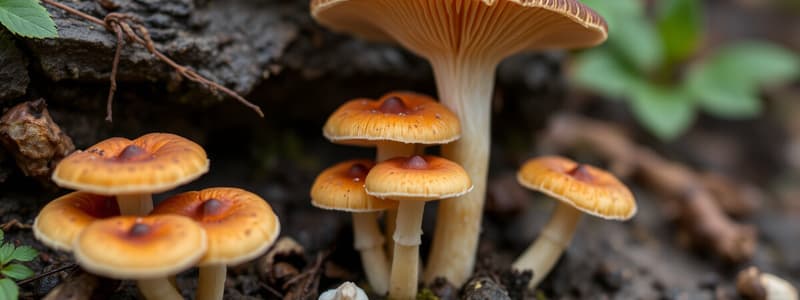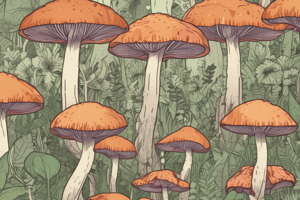Podcast
Questions and Answers
Taxonomy is the subdiscipline of identifying, naming and classifying ______.
Taxonomy is the subdiscipline of identifying, naming and classifying ______.
plants
Living organisms are made up of ______.
Living organisms are made up of ______.
cells
Non-living materials can vary widely in their ______.
Non-living materials can vary widely in their ______.
forms
Living organisms exhibit internal ______.
Living organisms exhibit internal ______.
Non-living entities cannot ______ food materials.
Non-living entities cannot ______ food materials.
Living organisms can move by ______ themselves.
Living organisms can move by ______ themselves.
Irritability in living organisms is the ability to reset to changes in the ______.
Irritability in living organisms is the ability to reset to changes in the ______.
Non-living materials depend on their ______ for structure.
Non-living materials depend on their ______ for structure.
Plants can manufacture their own food through ______.
Plants can manufacture their own food through ______.
Animals depend on plants and other animals for their ______.
Animals depend on plants and other animals for their ______.
The body form of animals is often ______.
The body form of animals is often ______.
Theophrastus is known for classifying plants into four categories: trees, shrubs, ______ & herbs.
Theophrastus is known for classifying plants into four categories: trees, shrubs, ______ & herbs.
Mycology is the study of the biology of ______.
Mycology is the study of the biology of ______.
Dioscorides wrote a five-volume book called ______ Medica.
Dioscorides wrote a five-volume book called ______ Medica.
Mimosa pudica is a type of ______.
Mimosa pudica is a type of ______.
Pteridology is the study of ______ and similar plants.
Pteridology is the study of ______ and similar plants.
Phycology is the study of ______.
Phycology is the study of ______.
Plants respond slower to stimuli and do not have a ______.
Plants respond slower to stimuli and do not have a ______.
Agronomy involves the practical use of plant and soil sciences to increase the yield of ______ crops.
Agronomy involves the practical use of plant and soil sciences to increase the yield of ______ crops.
The causes of plant growth were explored in Theophrastus's book called De ______ Plantarum.
The causes of plant growth were explored in Theophrastus's book called De ______ Plantarum.
The study of diseases of plants is known as ______.
The study of diseases of plants is known as ______.
Biotechnology refers to the study and manipulation of ______ within and between species.
Biotechnology refers to the study and manipulation of ______ within and between species.
Forestry is the study of forest management and the utilization of forest ______.
Forestry is the study of forest management and the utilization of forest ______.
Natural Resource Management emphasizes the responsible use and protection of our natural ______.
Natural Resource Management emphasizes the responsible use and protection of our natural ______.
Hieronymus Bock published the book Herball or Generall Historie of ______ in 1597.
Hieronymus Bock published the book Herball or Generall Historie of ______ in 1597.
Otto Brunfels was listed among the 'Fathers of ______' by Carl von Linne.
Otto Brunfels was listed among the 'Fathers of ______' by Carl von Linne.
Linnaeus named the genus ______ (a genus of about 40 species of neotropical shrubs) after Otto Brunfels.
Linnaeus named the genus ______ (a genus of about 40 species of neotropical shrubs) after Otto Brunfels.
Leonhart Fuchs is known as the third of the German fathers of ______.
Leonhart Fuchs is known as the third of the German fathers of ______.
The exact total number of kinds of plants on Earth is ______ and about 350,000 species are known.
The exact total number of kinds of plants on Earth is ______ and about 350,000 species are known.
Until after the Renaissance, plants were classified chiefly on ______ characters such as growth habits and leaf structure.
Until after the Renaissance, plants were classified chiefly on ______ characters such as growth habits and leaf structure.
The ______ system of classification groups organisms based on superficial resemblances.
The ______ system of classification groups organisms based on superficial resemblances.
The ______ system, initiated by Carolus Linnaeus, is based on evolutionary relationships of organisms.
The ______ system, initiated by Carolus Linnaeus, is based on evolutionary relationships of organisms.
Thallophytes do not develop a(n) ______.
Thallophytes do not develop a(n) ______.
The main component of the cell wall is ______.
The main component of the cell wall is ______.
The living component of a plant cell is known as the ______.
The living component of a plant cell is known as the ______.
Mitochondria are known as the main sites of ______.
Mitochondria are known as the main sites of ______.
Ribosomes are associated with ______ synthesis.
Ribosomes are associated with ______ synthesis.
Lysosomes contain hydrolytic or ______ enzymes.
Lysosomes contain hydrolytic or ______ enzymes.
Chloroplasts contain ______ and carotenoid pigments.
Chloroplasts contain ______ and carotenoid pigments.
The outermost part of the nucleus is called the nuclear ______.
The outermost part of the nucleus is called the nuclear ______.
Microtubules are associated with ______ in cell division.
Microtubules are associated with ______ in cell division.
Vacuoles are fluid-filled structures that contain various dissolved ______.
Vacuoles are fluid-filled structures that contain various dissolved ______.
Study Notes
Mycology and Botany Specializations
- Mycology focuses on the biology of fungi, a diverse group critical for ecosystems and medicine.
- Pteridology is the study of ferns and related plants, essential for understanding plant evolution and diversity.
- Phycology concentrates on algae, vital for aquatic ecosystems and oxygen production.
Applied Botanical/Plant Sciences
- Agronomy applies crop and soil sciences to enhance the yield of field crops.
- Plant breeding aims to develop improved plant varieties with traits like disease resistance.
- Biotechnology involves gene manipulation to produce beneficial products using biological organisms.
- Economic botany studies how humans utilize plants, analyzing both harmful and beneficial species.
- Food science and technology focus on developing food products from various plant sources.
- Forestry encompasses forest management and the sustainable use of forest resources.
- Horticulture is the cultivation of ornamental plants, fruits, and vegetables.
- Natural resource management emphasizes responsible resource use and protection for societal benefit.
- Plant pathology investigates plant diseases to enhance agricultural productivity.
- Phytochemistry examines plant biochemistry and the chemical processes involved in plant life.
- Systematics studies the evolutionary relationships among plants, including their classification.
- Systems ecology uses mathematical models to understand plants' roles in ecosystems, like nutrient cycling.
- Taxonomy identifies, names, and classifies plants into organized categories.
Living vs Non-living Criteria
- Living organisms possess defined forms, coordinated cellular organization, and can grow and reproduce.
- Non-living entities do not exhibit cellular organization, do not metabolize, and lack the ability to reproduce.
Plants vs Animals
- Plant bodies exhibit variable forms while animal bodies are constant; plants have rigid cell walls made of cellulose.
- Plants manufacture food through photosynthesis, whereas animals rely on the consumption of plants or other animals.
- Plants respond more slowly to stimuli compared to animals, which possess a nervous system for faster reactions.
Historical Figures in Botany
- Theophrastus, often called the "Father of Botany," classified plants and authored significant botanical texts.
- Pedanius Dioscorides significantly influenced pharmacology with his work "De Materia Medica."
- Hieronymus Bock published "Herball," advancing plant classification and nomenclature.
- Otto Brunfels is recognized among the "Fathers of Botany" for his contributions to plant identification.
- Leonhart Fuchs authored "Notable Commentaries on the History of Plants," contributing to plant classification.
Plant Classification
- Approximately 350,000 plant species are recognized, underscoring the vast diversity of the plant kingdom.
- Taxonomy focuses on plant classification, historically based on growth habits but now prioritizes reproductive structures.
Plant Kingdom Classification
- Thallophytes (e.g., bacteria, fungi, algae) do not develop embryos, while Embryophytes (e.g., trees, flowers) do.
Structure of Eukaryotic Plant Cells
- Key components of living plant cells include the cell wall, protoplast (encloses organelles), and inclusions.
Cell Components
- Cell Wall: Composed mainly of cellulose; serves as a protective non-living structure.
- Protoplast: Living part of the cell, divided into cytoplasm and nucleus.
- Plasma Membrane: Selectively permeable, regulates entry and exit of substances.
Organelles and Their Functions
- Mitochondria: Sites of cellular respiration; contain double membranes with folded inner structures.
- Ribosomes: Involved in protein synthesis, visible only under electron microscopy.
- Golgi Bodies: Package and secrete cellular materials; structured in multilayered complexes.
- Lysosomes: Contain digestive enzymes for cellular waste disposal and recycling.
- Plastids: Include chloroplasts (photosynthesis), leucoplasts (food storage), and chromoplasts (pigment storage).
Nucleus and Its Components
- Nucleus: Control center for cell activities.
- Nuclear Membrane: Regulates material passage in and out of nucleus.
- Chromatin: Contains hereditary information visible during cell division.
- Nucleoli: Synthesize ribosomal RNA essential for ribosome formation.
Inclusions
- Non-protoplasmic structures such as vacuoles (storage of substances) and crystals (various functions) are present in plant cells.
Studying That Suits You
Use AI to generate personalized quizzes and flashcards to suit your learning preferences.
Related Documents
Description
Test your knowledge on mycology, pteridology, and phycology. Explore the applied sciences of botany, including agronomy, plant breeding, and biotechnology. This quiz covers essential concepts that highlight the significance of plants and fungi in ecosystems and human use.




